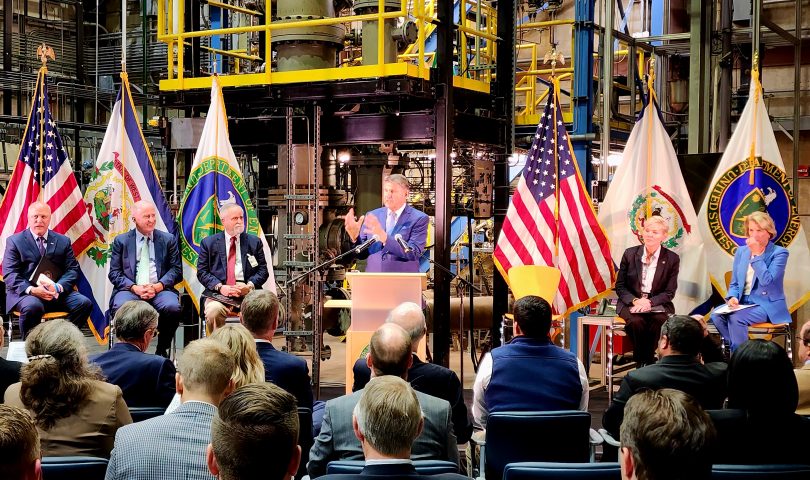MORGANTOWN – Sen. Joe Manchin and Shelley Moore Capito and former Rep. David McKinley joined with U.S. Energy Secretary Jennifer Granholm and dignitaries from across the state on Monday to celebrate the selection of the Appalachian Regional Clean Hydrogen Hub (ARCH2) as one of seven such hubs across the nation.
Granholm described all the clean, green uses for hydrogen – transportation, industry, home energy, agriculture and more. “It is the most versatile energy source. And you here, in West Virginia, you are going to be leading the nation in this new, clean energy world.”
The celebration took place at Morgantown’s National Energy Technology Laboratory, which will be participating in the research portion of building out the hub. ARCH2 is centered in West Virginia and including Ohio and Pennsylvania and will be eligible for up to $925 million in federal support under the Bipartisan Infrastructure Law.
Manchin, who played a lead role in crafting the Bipartisan Infrastructure Law, emceed and opened by talking about how West Virginia has done the heavy lifting to power the nation and now will be at the forefront of innovation, job creation and energy independence. “You’d better be energy independent if you want to be energy secure,” he said.
Marshall University President Brad Smith said, “This is a milestone moment in West Virginia state history. … This represents economic opportunity for our state,” in jobs, investments, education and innovation – with private industry and higher education working together on research and development.
WVU President Gordon Gee echoed that, adding, “It’s going to establish Appalachia as the nation’s center for hydrogen research and hydrogen solutions.”
McKinley was a leading infrastructure bill supporter in the House, which, as several people noted, cost him his seat when then-President Trump gave his endorsement to McKinley’s primary election opponent.
McKinley talked about the history of the infrastructure law. “We wanted this state and these universities to be the epicenter of energy development in this country.”
But carbon capture posed an obstacle. When a bill he coauthored failed, the infra law, blending energy and infrastructure, filled the gap. Now, to build out the hydrogen economy, we need carbon capture, pipelines to get the hydrogen where it needs to go and underground storage to keep it until it’s needed.
“This legislation is going to have a profound effect on us in West Virginia. It’s going to put us back into the mantle of leadership we’ve somewhat lost over the years in addressing energy.”
Capito was among those who praised the unity fostered to secure the hub selection, and Monday’s crowd at NETL included people from all across the political spectrum.
ARCH2’s selection, she said, solidifies West Virginia, Pennsylvania and Ohio as an energy region for generations to come. “Partnerships work. And when you work together … when you listen to the other side or other people who have different ideas, you can pull it together and work.”
And the hub, she said, demonstrates that energy and the environment aren’t mutually exclusive. We can do both. “It can be an economic win and an environmental win.”
Manchin introduced Monongalia County Commissioner Tom Bloom as the “economic energizer bunny.”
Bloom said, “We are ecstatic. … This is a transformational change.” It means more money for schools, infrastructure, economic development and a better quality of life for all. He told Granholm, “By us working together, we will accomplish these projects that you set before us.”
Toby Rice is CEO of EQT, the nation’s largest natural gas producer. Rice said the energy we are producing isn’t enough. “America needs to do more. … America is the solution. The way we are going to get out of this crisis and give ourselves the energy security that we demand and the energy security for the world that they deserve is though leadership.” ARCH2 “is giving an opportunity for our industry to come back and lead.”
Andy Marsh is CEO of Plug Power, a hydrogen producer “building an end-to-end green hydrogen ecosystem. He said a new hydrogen production plant will be built in West Virginia and Amazon, one of its clients wants the product. Nationally, Bloomberg estimates the hydrogen industry will generate $10 trillion in investments by 2050. “Lots of money is coming in this industry.”
Granholm said the $925 million in federal funding for ARCH2 will generate $5 billion in private investment. For all seven hubs, the $8 billion will generate $50 billion. “That is private sector-led, government enabled.”
There will be 10 production sites across the ARCH2 footprint, including Fairmont, Follansbee, Parkersburg and Point Pleasant. And the ARCH2 hub will exceed all the other hubs in reducing carbon emissions in its region.
During a Q&A after the main event, The Dominion Post asked how long it might take for the hub to take root and grow. Granholm said, “This is a really complicated system. It’s a whole ecosystem.” It has to be planned, built and operated. “It is going to take some time.”
Right now, she cautioned, the seven hubs are just selectees, and it will take a couple months to complete negotiations for the awards. “The bottom line is, if we get it right, it’s going to mean thousands and thousands of jobs.”
The seven hubs selected were drawn from among 79 that applied. Clean hydrogen hubs will create networks of hydrogen producers, consumers and local connective infrastructure to accelerate the use of hydrogen as a clean energy carrier that can deliver or store tremendous amounts of energy.
The White House said the $8 billion allotted for the seven hubs will catalyze more than $40 billion in private investment and create tens of thousands of jobs – bringing the total public and private investment in hydrogen hubs to nearly $50 billion. ARCH2 is expected to create more than 21,000 direct jobs – more than 18,000 in construction and more than 3,000 permanent jobs.
Email: dbeard@dominionpost.com




